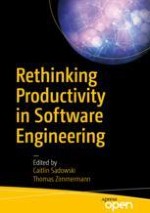Introduction
-
Controlled experiments that demonstrate that interruptions take time to recover from and lead to errors
-
Cognitive models that offer a theoretical framework for explaining why and how interruptions are disruptive
-
Observational studies that give a rich description of the kinds of interruptions that people experience in the workplace
Controlled Experiments
What Is the Aim of an Experiment?
A Typical Interruptions Experiment
How Is Disruptiveness of an Interruption Measured?
Interruptions Cause Errors
Moving Controlled Experiments Out of the Lab
Summary: Controlled Experiments
Cognitive Models
What Are Cognitive Models?
What Can Cognitive Models Predict About the Impact of Interruptions on Productivity?
Summary: Cognitive Models
Observational Studies
Observational Studies of the Workplace
Benefits and Detriments of Interruptions
Stress, Individual Differences, and Interruptions
Productivity
Strategies for Dealing with Interruptions
Summary: Observational Studies
Key Insights
-
Interruptions can take time from which to recover from and can lead to errors.
-
Shorter interruptions are less disruptive than longer interruptions.
-
Interruptions delivered during a natural break in a task are less disruptive.
-
Interruptions that are relevant to the current task are less disruptive.
-
Resuming a task too quickly can lead to errors being made.
-
All of these characteristics of the resumption lag can be explained by an underlying memory retrieval process.
-
People self-interrupt almost as often as being interrupted by external sources.
-
People often work on multiple tasks at the same time, and self-interruptions are important for keeping up with these different activities.
-
Interruptions can cause stress, particularly e-mail interruptions.
-
Interruptions can provide an opportunity for a break to refresh, and people take longer breaks after working on a task for longer.
Key Ideas
-
Controlled experiments are designed to test a specific hypothesis, but there are challenges with designing the experiment so that it has ecological validity.
-
Cognitive models offer a theoretical framework for explaining why and how things happen (e.g., how interruptions affect productivity), but these models can be complex and difficult to develop.
-
Observational studies offer a rich description of situated activity, but these studies are resource intensive and can produce an overwhelming amount of data of which to make sense.
Acknowledgments
References
https://doi.org/10.1145/2971648.2971751.http://www.jstor.org/stable/4165091.https://doi.org/10.1145/2702123.2702156.https://doi.org/10.1016/j.dr.2014.12.005.https://doi.org/10.1111/cogs.12513.https://doi.org/10.1145/3025453.3025700.https://doi.org/10.1037/0096-3445.135.1.103.https://doi.org/10.1145/1357054.1357070.https://doi.org/10.1145/1240624.12407302007.https://doi.org/10.1145/1718918.1718926.https://doi.org/10.1145/1518701.1518979.https://doi.org/10.1145/2858036.2858359.https://doi.org/10.1145/2675133.2675221.https://doi.org/10.1145/2858036.2858202.https://doi.org/10.1126/science.1131295.https://doi.org/10.1109/TSE.2017.2656886.https://doi.org/10.1037/a0014402 .http://www.pewinternet.org/2016/06/22/social-media-and-the-workplace/.https://doi.org/10.1145/264701.264706.https://doi.org/10.1145/2702123.2702593.https://doi.org/10.1145/3025453.3025662.